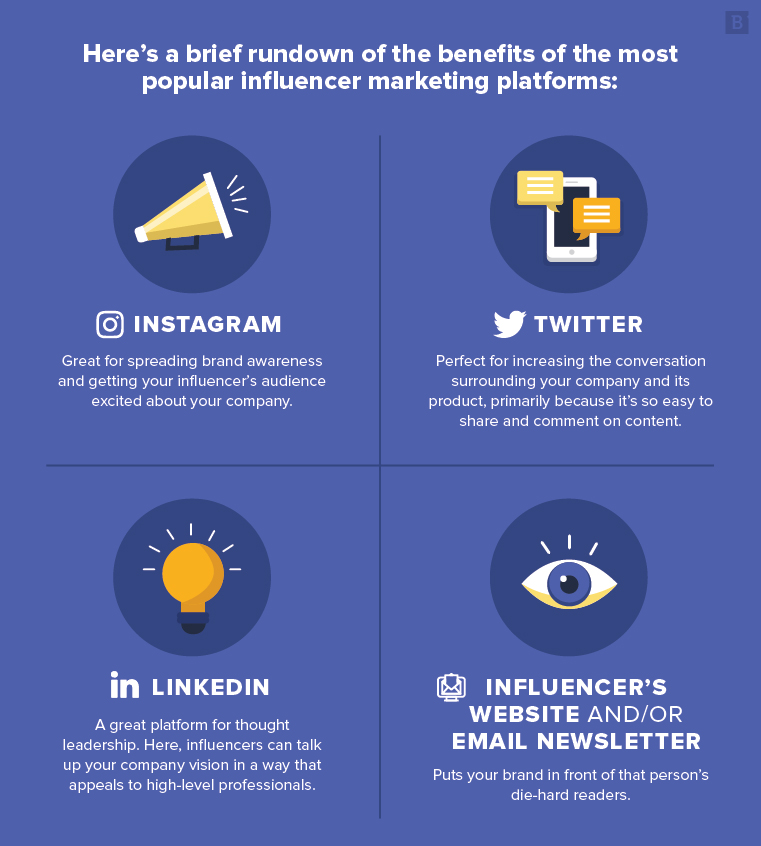Editor’s note: Updated November 2018.
We get it. Reaching out to your target market is tough. It’s so much easier to develop a relationship with a single person, then have that person tell their thousands of loyal followers why they should buy from your business, bringing you sales and expanding your company’s reach.
Okay, realistically, influencer marketing can’t replace your other campaigns completely. That said, it can be a great addition to your overall strategy.
What on earth is an “influencer”?
Influencers are people with hundreds or thousands of followers that match your target market. Apologies for breaking it to you so bluntly, but, yes, that number of followers is light years above yours. Influencers are well-respected industry thought leaders who often find fame through social media. The good news is that partnering with them, whether through short-term campaigns or longer investments, grants you access to all of their potential customers with minimal effort on your part.
If that famous life is a little too much for you to even watch from the sidelines, you can also utilize the power of micro-influencers. They don’t have quite as many followers as the traditional influencer, but the thousands that they do have are there to stay. That’s because micro-influencers often have a narrower focus that draws a distinct audience. While you have to work with multiple micro-influencers to get the same reach as celeb influencers, the return in audience engagement can be worth it. Micro-influencer marketing works especially well for brands that want to reach more niche audiences.
Key takeaway: Think of micro-influencers as the long-tail keywords of influencer marketing. It can be easier to reach a super engaged audience of 5,000 members rather than one with millions of followers.
But if you think launching an influencer campaign is as easy as sending a DM, you’re mistaken. Influencer campaigns are two-way streets. We’re talking about savvy, well-established business people, which means they want to know that partnering with you will be beneficial for their brands, not just yours.
Don’t let this fact scare you. Simply think of influencers as another source for content – an outside voice posting articles, social updates, images and video about your business. Most influencer partnerships take the form of short-term campaigns and are designed to promote a single product or service. They don’t, however, conform completely to your company guidelines. In this way, influencers are more like contractors than employees. They’re paid to accomplish a task, but they have some flexibility to achieve things in their own way.
Get an endorsement and grow your audience
So, why do you need influencers? Simply put, people trust third-party sources. Outbound marketing isn’t as effective anymore – it’s all about generating inbound leads, especially through digital marketing efforts, for higher levels of engagement. While your own content marketing efforts get the job done well enough, a glowing endorsement from someone in the industry can convert potential customers of skeptical minds to your brand.
That’s why review websites like Yelp and Amazon Reviews are so trusted. These people may not be industry experts, but they have expectations about the products and places they’re reviewing – expectations that are similar to those of other shoppers. Influencers are like Amazon reviewers but with more, well, influence.
Not only do people listen to influencers, but these people already have large audiences that you want to reach. Many of them are well-known and respected within their industry, either through detailed blog posts, conference and media appearances, speaking engagements or their prior industry history. People believe what they have to say, and you can meet a lot of people if influencers say you’re good.
Plus, if you don’t target those influencers, your competitors certainly will. You’ll want to win influencers to your side before other marketers get there first.
Here are a few tips for launching a successful influencer marketing campaign:
- Prioritize their branding guidelines, not yours. Influencers know what works for their audience much better than you do. Forcing your partner to create content in a different style or brand voice causes readers to doubt the influencer’s credibility. He or she will seem more like your puppet than a trustworthy source who believes in your brand.
- Diversify your platforms. Some influencers have a major presence on Twitter, while others are stronger on LinkedIn. Choose both instead of one over the other, and grab the attention of two audiences at once for double the engagement.
- Give them control. Let influencers promote your product or service in a way they feel comfortable. The more flexibility you offer, the more willing influencers will be to enter a partnership (unless you just throw tons of cash at them, of course).
Using influencers in B2B marketing
Still doubt the influencer marketing strategy? Take a look at the world of B2C marketing, specifically fashion and beauty. I could list probably a dozen partnerships between bloggers and brands live today. And these aren’t local companies or indie names; they’re major players like Target, Nordstrom and Macy’s.
Now, this article would have a lot more pictures of Rihanna if influencer marketing was only for B2C fashion and beauty brands. But like any form of content marketing, influencers have their place in B2B markets as well. Every industry has its own innovators and thought leaders, from manufacturing to enterprise software and beyond. And, yes, they are also making waves on social media.

Want to know who the best influencers in your industry are? Look at who writes the blogs you read, who creates the (relevant) Twitter posts you retweet, who’s invited to speak at the conferences you attend. These are the people you want talking about your brand.
Be our guest (blogger)
On that note, what if the “influencer” you want is less of a person and more of a publication – Entrepreneur, Forbes or an industry-specific website?
This is where guest blogging comes in to play. Instead of having the influencer create the content, you write it yourself and publish it on their website or social media profile. This gives you near-complete control over the content, but you still have to prove that you’ll be beneficial to the person or platform. Can you guarantee your content helps their marketing goals? Are you bringing something new to the table, or are you repeating content they’ve promoted 20 times over?
I don’t say this to discourage you, only to emphasize the point that influencer marketing is helpful for both parties. They’re giving you a boost in viewers and reach, but you need to show them results as well.
Be mindful of the FTC
Before we dive deeper into the idea of influencer marketing, we need to emphasize transparency. Influencer marketing is a form of sponsored content; done incorrectly and the Federal Trade Commission could come knocking on your door.
Essentially, readers need to understand that an influencer’s post is a piece of marketing, not something created of their own accord. The endorsement could be the same, but the FTC wants to make sure viewers know they’re looking at an ad – even if it isn’t coming straight from the brand..
Here’s a brief list of things to consider:
- Keep the disclosure at the beginning of your content so readers are alerted immediately.
- Use full words: The FTC frowns on #ad and #spon.
- If you’re using a social media platform, use that program’s native advertising tools rather than mixing influencer content with your regular posts.
- If the influencer is posting content on their platform, make sure it’s adequately disclosed when it goes live. Otherwise, you both could get in trouble.
For more information, check out this press release.
Now that we’ve got that out of the way let’s get to the fun parts.
Creating your strategy
As with any marketing project, a successful influencer campaign is all about strategy. Unfortunately, it’s all too easy for marketers to lead brands on a journey that starts on the wrong foot.
You may think your first task is to find influencers who resonate with you and your business. Instead, you think about what resonates with your audience. Who does your target market look up to? Which influencers have an audience that matches what you’re looking for? Is there someone who already gets a fair share of engagement from the people you want to love your brand, product or service?
Finding the right influencer for your target audience
Some influencers are a better fit for your brand than others. The Twitter King of Human Resources (not a real person, and whoever wants the title should know it’s up for grabs) might have 2 million followers who meet many of your demographic categories (professionals, 30-45, live in the city), but he’s probably not be the best person to promote your data-cleansing software. For that, you’ll want someone who catches your audience’s interest – none other than the Queen of Clean Data, of course. Her preferred social media platform is LinkedIn, and her audience is full of your dream clients.
However, if the Queen typically focuses on a different kind of content – say webinars and graphics instead of blog posts – partnering with her could be a great way to explore new media.
The long and short of it is this: Choose your influencers wisely. Go for someone who suits your marketing style and audience goals but can also help you explore new content types.
“That’s all good to know,” you say, “But how do I actually find one?”
When influencer marketing first got off the ground, getting them on board was a hunt. Searching for contact information, sending a message, working out a contract over email and refreshing web pages to see if the content went live.
Now, things are a lot easier. There are plenty of influencer marketing tools to help you find partners and track projects, including:
Each of these systems puts you in touch with thousands of influencers, but they vary in terms of content creation. Some are primarily focused on building trust, while others are full content creation platforms that let you track the performance of your various sponsored posts.
Choosing your platform
Influencer marketing is a great opportunity to expand your content platforms, spanning across the social and internet worlds. Mix and match where the content is posted to see what turns out to be most effective; if you see a great hit, you may want to focus on that platform for your own content a bit more.
Here’s a brief rundown of the benefits of the most popular influencer marketing platforms:
- Instagram is great for spreading brand awareness and getting your influencer’s audience excited about your company. Have your partner use compelling visuals and hashtags in these social posts.
- Twitter is perfect for increasing the conversation surrounding your brand and product or service, primarily because it’s so easy to share and comment on content.
- LinkedIn is a great platform for thought leadership. Here, influencers can essentially be cheerleaders, talking up your company vision in a way that appeals to high-level professionals.
- The influencer’s website and/or email newsletter puts your brand in front of that person’s die-hard readers. This is also an opportunity to link back to your content.

Emphasizing brand awareness
One of the great things about influencer marketing campaigns is their ability to get your company in front of fresh new eyes. As such, brand awareness should always be a key part of your strategy – and, if necessary, included in the contract between you and your influencer. Have your influencer include your brand and keywords in their copy, feature your logo or color scheme in any images, end their captions with your custom hashtags or some other tactic that lets their audience know who you are.
Incorporating user-generated content
Depending on how much creativity you allow, influencer marketing can be its own form of user-generated content. Your partners can create their own blog articles, Instagram updates, LinkedIn features and more, which you can then feature or link back to on your website and social profiles.
In fact, you can use influencers to increase your UGC by leaps and bounds: just have them ask their audience to create UGC that supports your brand – and say hello to some fresh engagement.
On Instagram, for example, you could have an influencer post an image of himself with your branded hashtag and encourage his followers to do the same.
Tracking ROI
You’ll of course want to see results with all of this effort. While the platforms above allow you to track content performance, the best way to see if influencers are bringing you leads is to use UTM parameters. That acronym stands for Urchin Tracking Module, and the full term describes a bit of code you add to the end of a URL to track user actions.
How far did that priceless influencer reach go for your brand? Once clicked, links with UTM parameters send information back to Google Analytics, allowing you to see which links lead viewers back to your website and whether or not people converted. Add UTM parameters to the referral links in your influencer content to see who or what is driving the most leads or sales.
You can also offer discounts for content viewers. You’ll see this a lot in B2C influencer marketing; partners will share a unique code that customers can input during the checkout process. While this idea is obviously easier if you run an e-commerce business, you can still think of creative ways to reward the people who discovered your business through such a partnership.
Another way to track your influencer marketing campaign ROI is to use a campaign monitoring platform. Once set up, this type of tool can automatically collect all of your influencer content (and each post’s performance), including Instagram stories before they disappear. That makes it easy to keep track of all your partner content, compare performance, and make quick reports.
Examples of great influencer marketing
Showing is better than telling, right? Well, not always, but I believe showing you some examples of good influencer marketing content will help you make your own creative campaigns.
Love My Store by American Express
First, let’s look at American Express. In 2015, they partnered with blogger and small-business owner Grace Bonney (of Design Sponge) and design blogger and influencer Emily Henderson. Bonney designed decals for small businesses to display, alerting customers that the establishment took American Express. Meanwhile, Henderson made a video of design tips to help small businesses attract new customers.
According to the company’s Shorty Awards entry, Amex distributed more than 400,000 campaign-designed decals, making them the most-ordered of the company’s offer. Online, the campaign garnered more than 5 million total impressions and over 50,000 social engagements from small-business owners. (Cue B2B marketers green with envy at those engagement numbers.)
G.E. and Lenny Letter
If you want ideas for partnering with a publication, look at G.E.’s campaign with Lenny Letter, Lena Dunham’s feminist online newsletter. Given that the campaign’s goal was to encourage women to enter the tech industry and that Lenny Letter is one of the most well-recognized platforms targeting millennial women, the partnership makes sense.
The weeklong campaign included an interview between Dunham and G.E. Vice Chair of Business Innovations Beth Comstock, along with science fiction stories, G.E.-inspired art and interviews with notable women in tech.
#MakeWhatsNext from Microsoft
Want one more? Microsoft partnered with National Geographic with the same goal as G.E.: to encourage more women in tech. While this partnership seemed less likely (and its objective less obvious), the result was an incredibly stunning visual campaign.
Launched on International Women’s Day 2017 and #MakeWhatsNext, the partnership used photos, video and storytelling to feature the amazing accomplishments of women in science and technology and promoted a series of free workshops Microsoft hosted around the country. It brought the tech company over 1.5 million online impressions on National Geographic’s distribution channels and almost 300 attendees at its workshops. When factoring in Microsoft’s live streams of the events and latter videos, the workshops reached 2.7 million total views in the days that followed.
See? If you haven’t yet experimented with influencer marketing, 2018 is the time to do it.
So, marketers, it’s time to ask yourself: Who are some of the major influencers in your industry, and how would you build a campaign with them?





